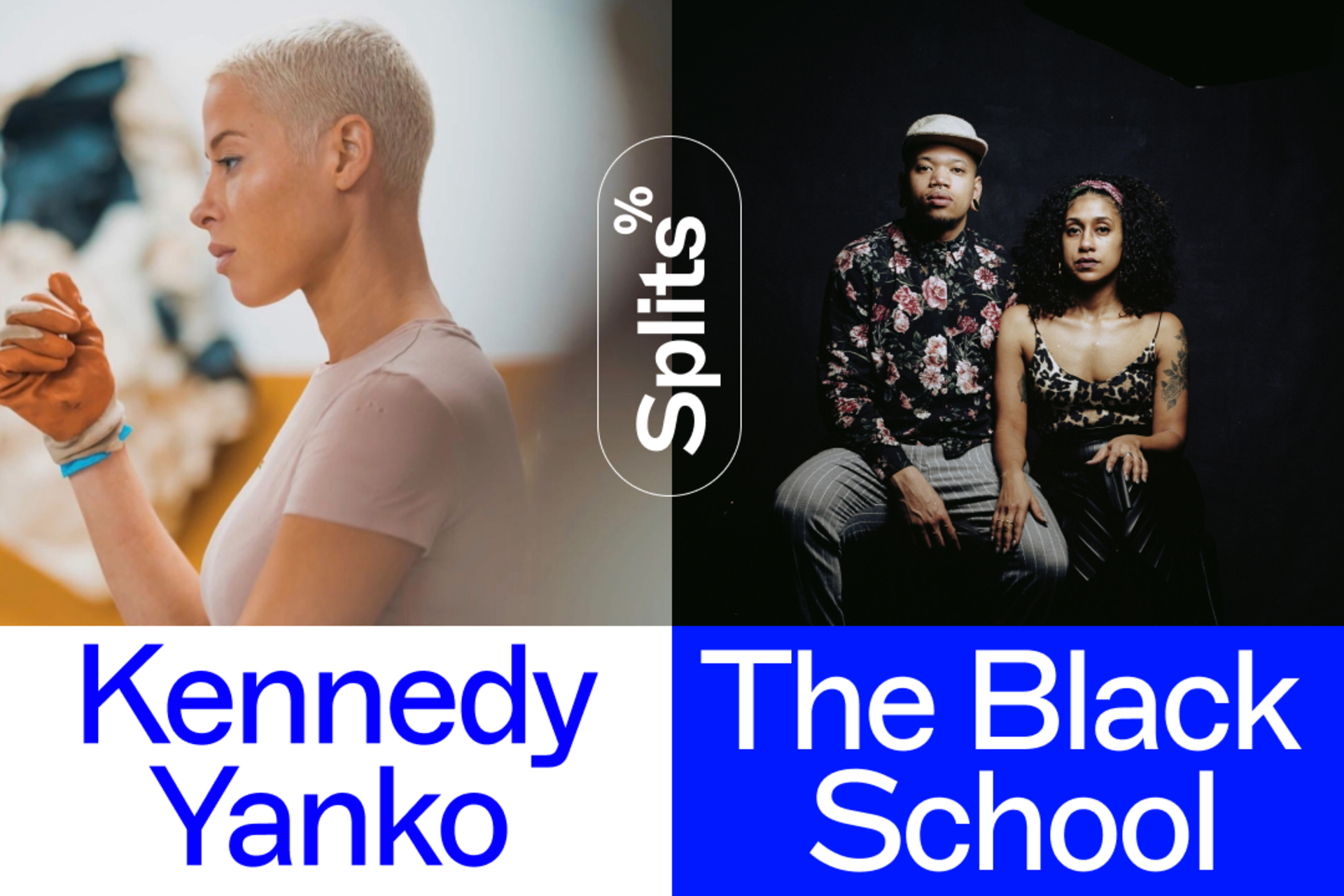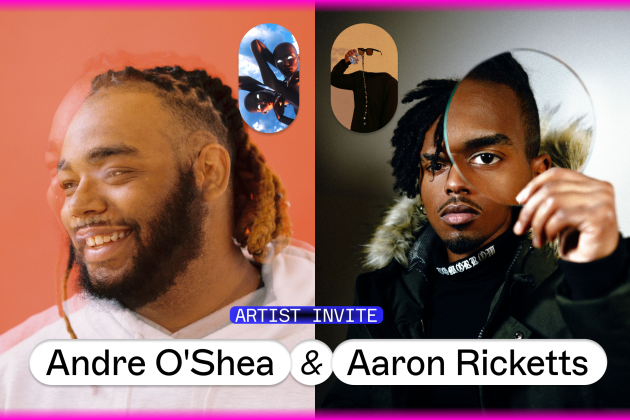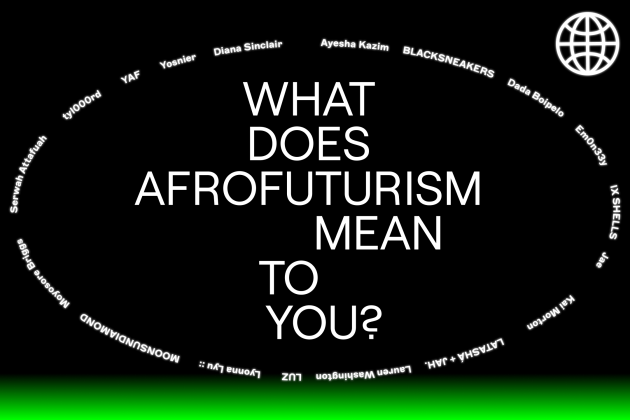Kennedy Yanko Splits with The Black School

Multidisciplinary artist Kennedy Yanko’s tools for psychic and creative exploration vary widely. Her practice is imbued with Qigong and energy work, aspects which allow her to move beyond her rational self, and into a more intuitive mindset. Given the intensely physical nature of her large-scale metal works and sculptural paintings, which make use of manipulated “paint skin,” or poured paint, this approach makes a lot of sense. Beyond the physical, her digital artwork pushes into a new terrain where she taps into the raw material of inner life. Similarly, her first NFT, Indelible Fluidity, stems from an idea for an original VR experience that channels samādhi, or oneness, within the viewer.
Using Splits, proceeds from the sale of Yanko’s work will automatically benefit her collaborator Jesus Caldron, as well as The Black School, an experimental art program and community center that teaches radical Black politics and art for social change. In the following interview, we chatted with Kennedy about sifting through her subconscious to create immersive spaces, and connected with The Black School’s co-founder Joseph Cuillier III to learn more about the work they’re doing to create opportunities for Black artists.
KENNEDY YANKO
Your work in sculpture is pretty involved—the process includes sourcing scrap metal before arduously bending, cutting, and welding it into form. How does that process translate to the way you’ve approached your digital work?
I use found metal, but I also use a material called “paint skin.” Paint skin is basically a large body of poured paint that is dried, and can then be manipulated. In this way, I'm using paint as a sculptural material. I think the give and take in finding the reciprocity between two materials is really what has taught me so much about making in general. A lot of that learning boils down to taking everything one step at a time, and allowing the materials to show me what the next step might be. So for me, there's this embedded sense of responsivity in making—whether it's creating an installation or a performance or a sculpture or an NFT. I do as much research as I can, and then I just take everything one step at a time.
I’m fascinated by your project Indelible Fluidity and the metaverses and universes that you’ve been contending with in your sculptural paintings. How are you translating painting in three-dimensional space to the multi-dimensionality, so to speak, of NFTs?
That approach stems from my installation practice and my performance practice. I am creating environments and spaces for people to immerse themselves in, and to help them possibly understand something more deep or intrinsic about themselves. The initial idea for Indelible Fluidity was to use technology as a conduit to a metaphysical experience. I was wondering: how can I create the feeling of samādhi, or oneness, within a VR headset? How can I envelop that sensation for a viewer to give them an inkling, or a taste, of oneness? That was the initial desire for the project experientially.
My painting and my sculptures are really the place where I'm working through labor, and where I'm working through repetition, and where I'm working through discipline. I think that is the incubator for my ultimate expression. My sculpture practice and my installation practice are incubators for thoughts, ideas, and research, and the two practices just start to meld together.
Because sculpture is so multifaceted, when you move around, it always has a different face, and a different story. They take you in, in the same way that a little world would, or a terranean space would, where you want to get up close to it. You want to explore, you want to ride through the hills and the valleys of its skin. You want to touch it, and become a part of it, and immerse yourself into it. So there's this physical invitation that happens within the sculpture work, and it's been really fun trying to explore that within the digital realm.
In Indelible Fluidities, when it begins, it’s zoomed out so that it actually almost resembles chips of paint. And then, suddenly, you’re looking into these intricate universes. Can you share more about the specific shrines that it embodies?
The three shrines represent the ethereal, the womb, and the deaths. I'm thinking about the shrines more as transitory modules. I did a project a long time ago where I brought people into this room and took them through different experiences vibrationally. Some people came out of the room crying, and some people came out overjoyed. This experience helped me realize that to get people into a specific state of mind, or into a specific physicality, you have to take them through different stages of relinquishing the intellectual mind.
The initial project Indelible Fluidity is basically a three-person VR experience. As a viewer, let’s say you go into the womb shrine. This puts you into a landscape where you're looking at the hills, valleys, and lagoons from the natural texture of the paintings—but then you walk into this immersive kind of realm that's pink, fluid, slushy, and familiar yet unfamiliar. You're there for about a minute or two, and then your body actually gets sucked to the top of the shrine. Once there, you're looking out at the landscape, and you see the two people that you started the experience with, floating over the death shrine, and floating over the ethereal shrine. As you're looking at the other viewer standing over the ethereal shine, you start to see their face reflected in your face, and they see themselves in you. It’s this gesture towards the idea of samādhi, which is the idea of oneness or the integration of love and all things. And the reality of that is almost at an atomic level.
You talk about the idea of holograms in space, and I learned that you practice Qigong and energy work. How exactly does that come into play in your digital work?
I used to teach Hun Yuan Qigong when I was younger. I studied with my Sifu for seven years, pretty intensely. And I think for me, Qigong, energy work, automatism, and all these other physical and mental austerities are ways of just tapping in and moving beyond my physical self. They're tools for me as an artist in the same way that a paint brush would be. And I think by using these practices and these methodologies, it's just allowed me to be able to tap in where and when I need to, and use those forms of discipline to explore my art practice even more deeply. So I don't know that I could exactly say how it relates, but it was the conduit for this information to be able to become a reality.
If everything in this world is made of energy and has a vibrational frequency, I’m curious whether you feel that digital space has an energy, or vibrational frequency as well?
When I think about vibrational frequency, I just think of atoms as the core makeup of everything. That’s proven, and there, and real. And one of the things that I think is really interesting about the digital space in general is that it's somewhat of a reflection of the way that we can absorb and transmit language and information with our bodies. I think that not very long from now, we're definitely going to be communicating telepathically—and in many ways, we already do. I mean, if you sit down with two artists who are having a conversation about their work, it's typically a lot of grunting, and a lot of big gestures. There are so many forms in which we communicate and exchange already as humans.
On a more surface level, we haven’t yet implemented the instruments necessary to be able to directly tap into these spaces. But I think technology is an interesting reflection of what is already a possibility within the web of consciousness that surrounds everything. So it’s maybe more of a mirror, or more of a reflection of possibility. And we can go either way with it. We're either going to be more dependent on being digital, or being digital is going to be a facilitator to our greater expansion.
When did The Black School get on your radar? What made you decide to split with them?
One of the galleries that I work with donated to The Black School for my birthday. Before that, I had never heard of them. But I looked into them and intuitively understood what they were doing, and then I got on the phone with Joseph and I was like, "Hey, I would love to support you guys in any way that I can. I think what you're doing is really important." I know how hard it is to create art and try to make money. It's not an easy thing. And really what they're doing is they're paying artists, and they're facilitating them to be able to use their skill set and stay within a creative mindset and make money from that. They're giving them the tools to be successful, and they're giving them connections.
THE BLACK SCHOOL'S JOSEPH CUILLIER
Can you tell me a little bit about The Black School, and what you’ve been doing for BIPOC students and artists?
The Black School is an experimental art school, where we teach young people and grown folks art-making and Black radical politics. It's an attempt to bring more activism and Black history into fine art, design, and public art. It’s kind of a different medium that my wife Shani Peters and I have become dedicated to exploring.
Through The Black School, we are supporting artists of color by hiring them to teach classes that share their practices with their own community, and by putting on Black Love Festival, which we throw every year. We give artists opportunities to activate the space, launch projects, and create different forms of engagement with a mostly Black audience, which is not always easy to come by in the art world.
This hybrid model of school, community center, and house posits a more intimate understanding of what Black artists need. You also recently left New York for New Orleans to migrate your model for the experimental art school for young people–can you share more about your plans?
So I'm originally from the West Bank, which you can think of as the suburbs of New Orleans. Well, not suburbs in our traditional American context. It's still very Black, poor, or working class folks, but it's just ten minutes from the actual city limits. Moving here was an opportunity for us to start our family, to get closer to other families, and to be among a village. But it also is the opportunity for us to take this project we've been doing in New York, and bring it somewhere where there's space for it to grow.
How did you get connected with Kennedy's work, and what are your thoughts around her splitting the proceeds from her NFT with The Black School?
I'm not really sure when I became aware of Kennedy's work—I think it was just through the ether. Aesthetically, I loved her work right away. I loved what she was doing, with the upcycling and the different materialities. I think she was already successful when I discovered her, but I see her leveling, and leveling, and leveling, which is dope. And as far as her choosing to support The Black School, it's very much appreciated.
We have this complicated relationship with the art world. There's a lot of freedom and space given to folks and to their passions, and for them to make a career out of whatever they make. You can essentially call anything art, and if folks like it, then you'll be successful. But we also see the art world as a space where folks can live and die in symbolism. People use Blackness as a material to mine for inspiration, but not really live that life–they can often extract from the community, without investing back.
So, what Kennedy's doing, and what I see a lot of other BIPOC artists doing—weaving their success and their honor throughout their creativity, and investing that back into their communities—is essentially the core of our beliefs. It’s why we do what we do. I see the museum and gallery system as a problem in a lot of ways. So creating these new models, and these new ways for folks to gain value from the creativity and the work they’ve made, in a way that's more accessible—I think that's an inspiring direction.
Read more

Chris Torres on building the Meme Economy.

Artist Invite: Andre O’Shea & Aaron Ricketts
